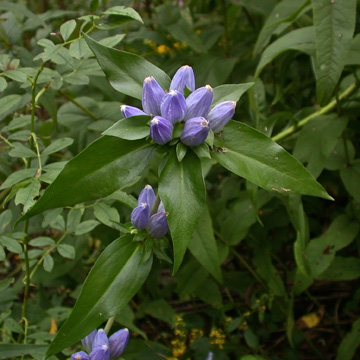

Gentiana andrewsii - (image 1 of 6)
Taxonomy
Family: Gentianaceae
Habitat
Moist meadows, woods, thickets. Tending to be a calciphile.
Associates
Distribution
NH and southern Quebec to MD and WV, west to southern Manitoba, MN, and MO, and sporadically to WY west of the Mississippi River (var. andrewsii)
Morphology
Perennial herb to 1 m; leaves opposite, lanceolate to obovate, to 4 cm wide, scabro-ciliolate; corollas blue, white at the base, 4-parted, more than 2.5cm long, the lobes scarcely prolonged beyond their adnation (connection) to the plaits into the narrow, truncate, and usually apiculate summit, the free tip barely 1 mm; plaits evidently exceeding the corolla lobes, fimbriate, forming most of the summit of the corolla.
Notes
Flowers September and October, usually a little late than G. clausa
Wetland indicator: FACW
The closed nature of bottle gentians compel pollinators to force their way into the flowers. White forms are occasionally found and grown as an ornamentals. The more eastern G. clausa Raf. is very similar but has firm, rounded corolla lobes about as long as the plaits, and the plaits shallowly 2-3-toothed or -lobed (not fringed).
References
Gleason, Henry A. and A. Cronquist. 1991. Manual of Vascular Plants of Northeastern United States and Adjacent Canada. Second Ed.
The New York Botanical Garden. Bronx, NY
Swink, F. and G. Wilhelm. 1994. Plants of the Chicago Region.
Indiana Academy of Science. The Morton Arboretum. Lisle, Illinois.
USDA, NRCS. 2002.
The PLANTS Database, Version 3.5 (http://plants.usda.gov).
National Plant Data Center, Baton Rouge, LA 70874-4490 USA.
|
Michael Hough © 2018 |